Tucked up in India’s far northeast, the Himalayan state of Sikkim is a unique area with Tibetan villages set below the snow-capped Himalayas. The world’s 3rd highest peak, Mt. Kanchenjunga (8586m), lies on the border between Sikkim and Nepal. We trekked to Goecha La (Pass) for a look at this mighty giant.
The high altitude, eight-day trek to Goecha La begins in the small Buddhist village of Yuksom. We spent a day visiting the Buddhist monuments and temples in this cute mountain village (For that story click here). The next day, we left Yuksom in the morning and hiked on steep trails through a dense rain forest filled with ferns, bamboo and unusual-looking alpine trees trees. In one area there were wild raspberries right next to the trail. The berries were ripe, so we ate a few handfuls each. They were delicious.
As we climbed higher the second day, we began to see rhododendrons that were starting to bloom in a variety of colours. The trail was busy not only with hikers, but also with yaks and mules carrying trekking and camping supplies. Yaks can only tolerate the cool air in the high alpine, so they’re not a common site in other parts of India.
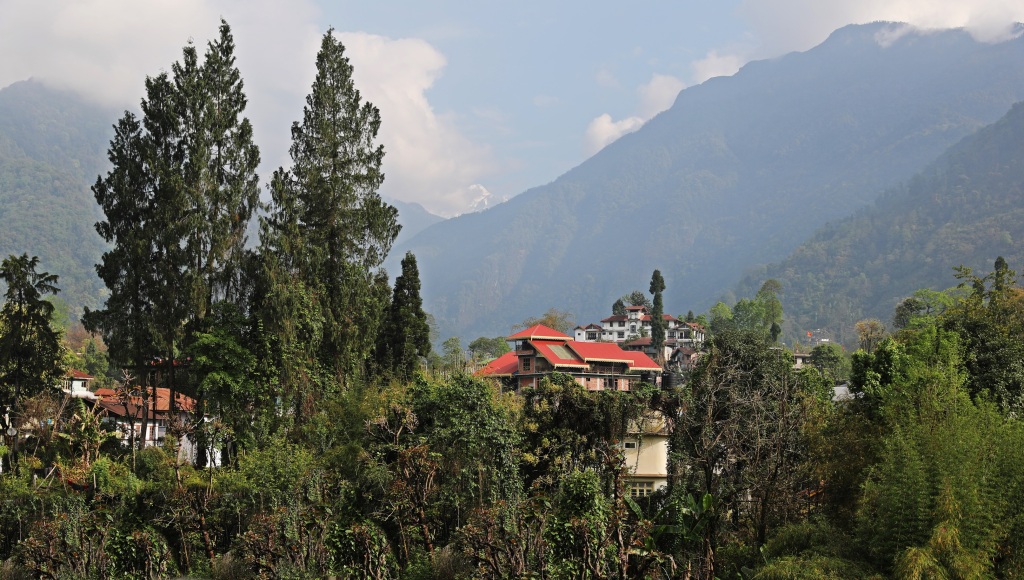
Yuksom with mountain views, Sikkim 
Interesting trees, Day 1, Goecha La Trek 
Waterfall, Day 1, Goecha La Trek 
Day 1, Goecha La Trek 
Interesting trees, Day 1, Goecha La Trek 
Rhododendrons, Goecha La Trek 
Yaks with loads, Day 2, Goecha La Trek 
Yaks with loads, Day 2, Goecha La Trek 
Bhakim Camp, Day 2 Goecha La Trek 
View from above Bhakim Camp, Day 2 Goecha La Trek
On the second night we stayed in an old, deserted Tibetan village. In 1950s and 60s large groups of Tibetans, including the Dalai Lama, fled Tibet for India traveling through this part of Sikkim. Some of those migrants settled in Sikkim, and established villages. In 1977, the Indian government declared this area a National Park. Because of this, the villagers had to, once again, leave their homes and move further south. Many of their old homes are still standing and the kitchens are now used by guiding companies. In the village is a small Buddhist Gompa and a few chortens sitting on the hilltops with mountain views all around. When we arrived, it was very cloudy and misty adding an eeriness to the abandoned village. The next morning though, we woke to an amazing view of the sun’s first rays shining over the campsite.

Sachen Gompa, Camp 2, Goecha La Trek 
Prayer wheels, Sachen Gompa, Goecha La Trek 
Chortens, Sachen Camp,, Goecha La Trek 
Sunrise, Sachen Camp, Goecha La Trek 
Sachen Camp, Goecha La Trek 
Sachen Camp, Goecha La Trek 
Sachen Gompa, Goecha La Trek 
Sachen Camp, Goecha La Trek
That day, we hiked higher and higher through rhododendron forests and caught a few glimpses of the high mountains above. We camped that night on a large, high elevation plateau, surrounded by Himalayan giants. The flat ground on the plateau made a perfect cricket pitch for the porters and muleteers. The next morning, we woke early and hiked to Dzong La Lookout, to see the sunrise. It was our first view of the mighty Kanchenjunga and the neighboring Himalayan peaks. We were treated to a beautiful sunrise behind the ridge and alpenglow on Kanchenjunga’s snowy peak.

Dorung Camp, Goecha La Trek 
Porters playing cricket, Dorung Camp, Goecha La Trek 
View from Dorung Camp, Goecha La Trek 
People on Dzongri Lookout, Goecha La Trek 
Sunrise reflecting off Kanchenjunga (centre right) from Dzongri Lookout 
Kanchenjunga (centre left) from Dzongri Lookout, Goecha La Trek 
Sunrise from Dzongri Lookout, Goecha La Trek 
Kanchenjunga far right, Goecha La Trek 
Chortens with Himalayas behind, Goecha La Trek 
Chortens with Himalayas behind, Goecha La Trek 
Chortens with Himalayas behind, Goecha La Trek 
Kanchenjunga Massif, Goecha La Trek 
View on Day 3, Goecha La Trek 
View on Day 3, Goecha La Trek 
Chortens with Prek River below, Day 3, Goecha La Trek
It rains a lot in this part of Sikkim. We usually woke to a beautiful blue sky, but by 9 am, the clouds rolled in to cover our views. Sometimes though, the cloud formations made dramatic pictures as they rose up from the valleys below. The other thing that comes with all the rain is moss. One forest we walked though felt like a spooky movie with the rhododendrons, pines and boulders covered in thick green moss.

Mountain view from trail, Day 3, Goecha La Trek 
Spooky moss forest, Day 3, Goecha La Trek 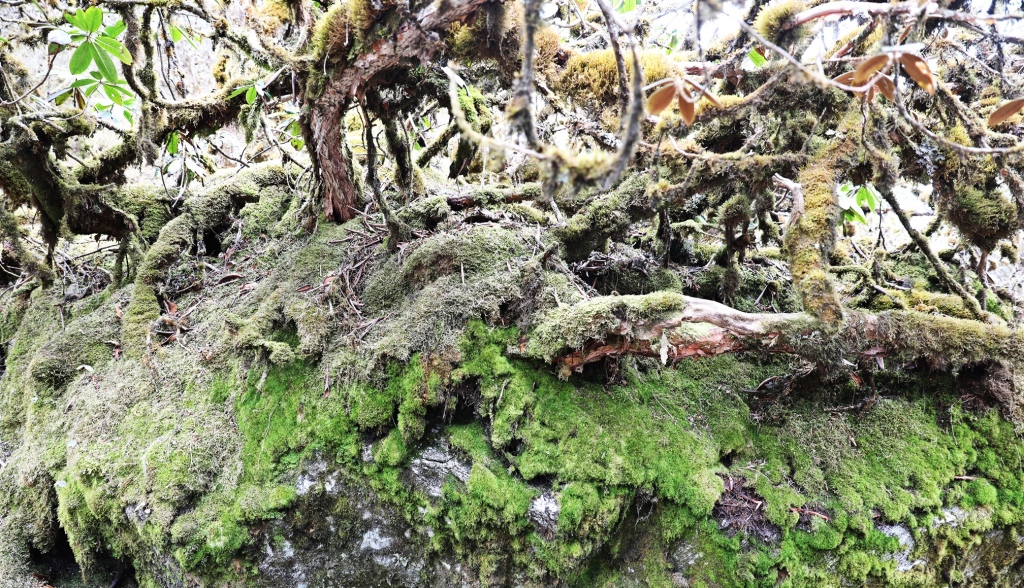
Spooky moss forest, Day 3, Goecha La Trek
The next two days were spent walking up a long, flat valley with a view of Kanchenjunga’s ridge in the distance. We camped one night at a site called Lamuney which means ‘long mani wall’. Mani walls are Buddhist structures composed of flat stones with the mantra ‘Om mani padme hum’ engraved on them. Beside camp is an old mani wall and two chortens with white oval rocks on top. The guides like to joke that these rocks are dinosaur eggs. They make a magnificent contrast to the tall glacier-covered Mt. Pandim, high above.

Kanchenjunga at the end of the valley from Thansing Camp, Goecha La Trek 
Kanchenjunga at the end of the valley from Thansing Camp, Goecha La Trek 
Kanchenjunga, Day 4, Goecha La Trek 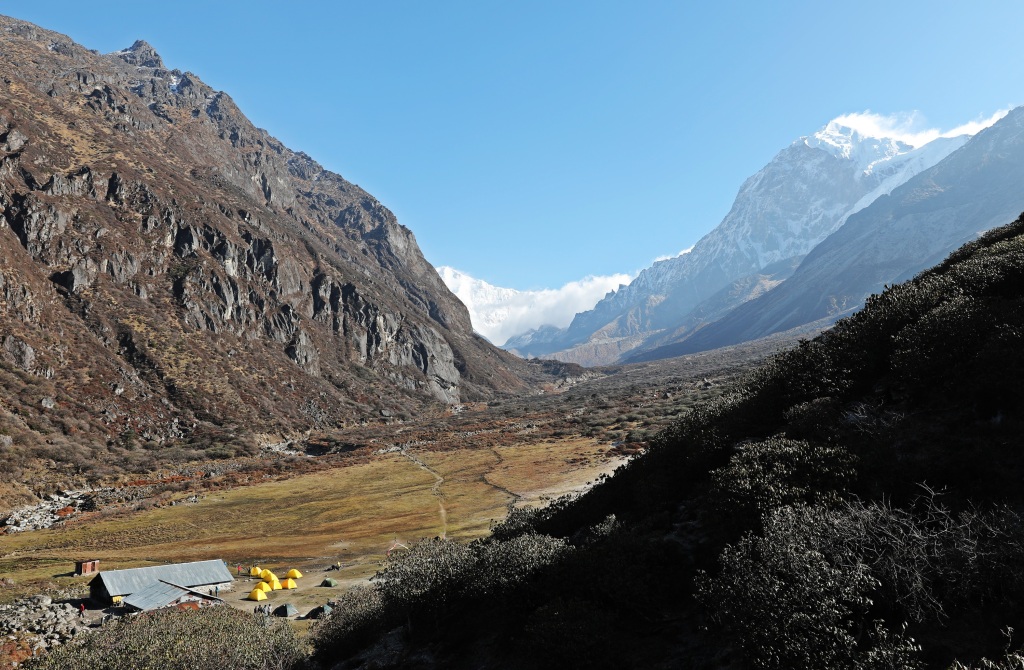
Kanchenjunga and Thansing Camp, Day 4, Goecha La Trek 
Kanchenjunga, Day 4, Goecha La Trek 
Pack horses, Lamuney Camp, Goecha La Trek 
Lamuney Camp, Goecha La Trek 
Mani wall with Mt. Padim behind, Goecha La Trek 
Dinosaur egg with Mt. Padim behind, Goecha La Trek
Finally, on day 6, we were going to get a close-up look at Kanchenjunga. We woke early (3:30am), hoping for a clear, starry sky but unfortunately it was different from the previous mornings as it was very cloudy. We weren’t sure that it would even be worthwhile to go to the lookout, but of course we did. We hiked up and up, through the moraine left behind from a receding glacier. After 1 hr 20 min we arrived at Goecha La. We had amazing views of the mountains on either side of Kanchenjunga with their lovely, snow capped peaks. High mountains like Kanchenjunga, however, are often shrouded in clouds as they produce their own weather. Today, Kanchenjunga was staying true to this by hiding behind a wall of clouds. Only small sections of the vast mountain would poke through the clouds for a few seconds before a new cloud rolled in. After 6 days, we were disappointed and unlucky.

Early morning cloud on the way to Goecha La 
Sunrise from Goecha La with Kanchenjunga behind clouds (middle right) 
Thumbs up rock, Goecha La 
Lenticular cloud, Goecha La 
View from Goecha La with Kanchenjunga behind clouds (centre) 
View from Goecha La 
Cloud covered Kanchenjunga (centre) from Goecha La
Walking back to camp we passed a calm mountain tarn reflecting the tall mountains on its flat surface. There were dozens of the gorgeous blue Grandalas and the shy White-Capped Redstarts, so the morning ended on a high note. The mountains are full of wild life such as blue sheep and the incredibly shy Himalayan Tahr, but they were more difficult to spot.
We still had another couple of hours to hike and the sky looked threatening. Once we finally arrived at our next campsite and got into our tent, it started to pour. It continued to rain steadily for the next 24 hours. The hike out the next day was wet and muddy with low, thick clouds and poor visibility all along the valley. We felt lucky to have seen as much as we did. The thick clouds mean that Kanchnjunga was not letting herself be seen from any lookout today. We later learned that Cyclone Fani was off the coast of West Bengal and was most likely the cause of the severe amounts of rain we had.
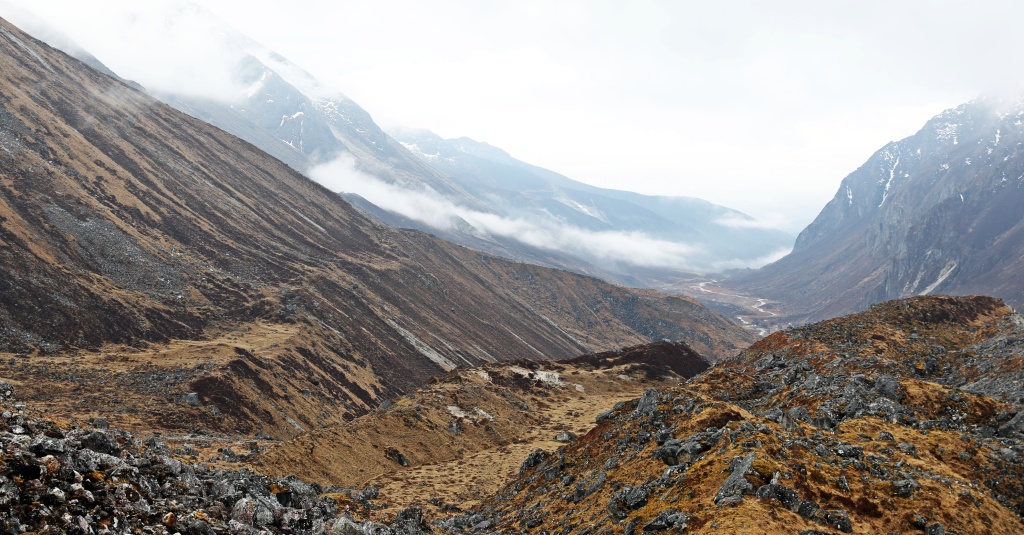
View down the valley, Day 5, Goecha La Trek 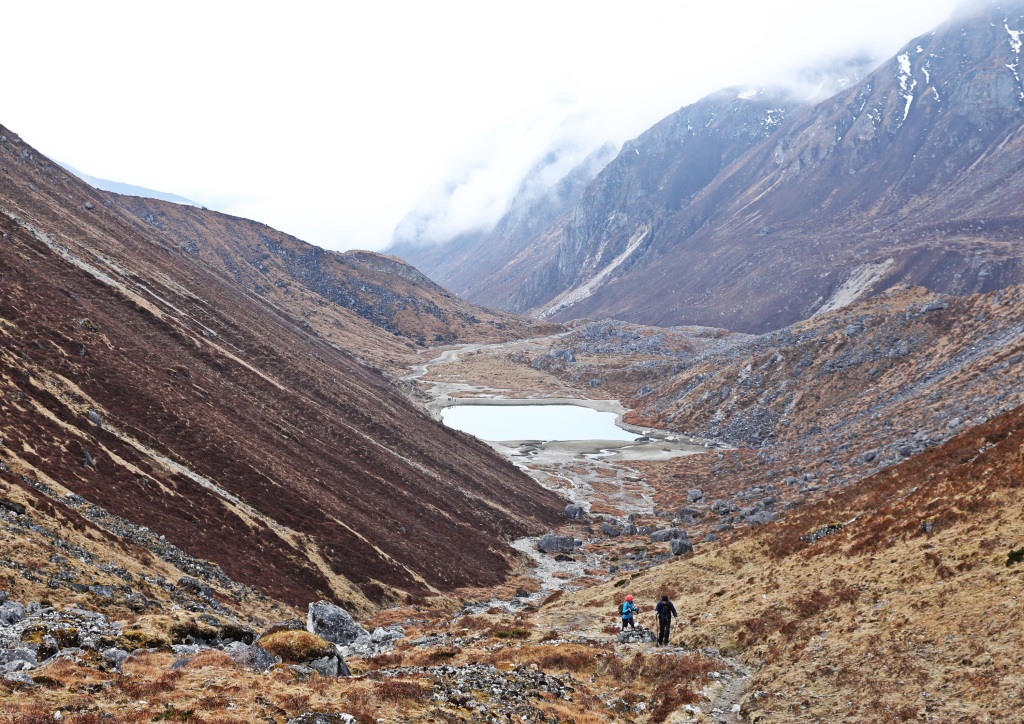
Samiti Lake, Goecha La Trek 
Samiti Lake and the trail to Goecha La beside the creek 
Grandala, Goecha La 
White-capped Red Belly, Goecha La Trek 
Himalayan Tahr, Sikkim
Interested in this hike? Click here for a Trekking Guide for Goecha La Pass, Sikkim
For extra pics from this trip go to Gallery/Northern India. For extra pictures from other blogs go to Gallery at monkeystale.ca
To read about more of our adventures go to Destinations.
If you like what you read, please comment or share it using the links below
Wow. What an exhilarating adventure! I love it.
LikeLiked by 1 person
Thanks Carl, it’s a gorgeous part of India.
LikeLike
Looks like you had some sunny weather despite the cyclone. Great pictures as usual, really envy your chance to trek there!
LikeLiked by 1 person
There was a beautiful blue sky almost everyday until about 9 or 10 am, so they’re mostly morning shots. It’s a great trek though.
LikeLike
Wow, your Himalian adventures look amazing, going on a trek through those stunningly beautiful mountain peaks would be a dream, come true moment for me.
LikeLiked by 1 person
There still there!! This one wasn’t very difficult and very inexpensive to hire a guide,. Put it on your list!
LikeLike
Sorry, *Himalayan* have a good day, guys
LikeLiked by 1 person
haha, Have a great day!
LikeLiked by 1 person
This looks a fantastic trek, scenery is stunning
LikeLiked by 1 person
It is a really nice trek going from rain-forest to alpine, the scenery is gorgeous. Thanks for reading!
LikeLike
The scenery is outstanding and even though you talk about cloud cover and inclement weather you sure got amazing photos. I love all your sunrise photos and the one you used as a header (with the yellow tents) is so captivating. That vivid blue bird is really cool and the yaks carrying the colourful loads. All makes me want to go!
LikeLiked by 1 person
Thank you Caroline. We had beautiful weather until about 9 or 10 am almost everyday, so that’s when most of the pictures are taken. It is a really great hike and I think fall would has weather, but no rhododendrons. There were at least 10 of those blue birds and their colour is as bright as the pictures. But 2 early mornings to hike for a sunrise view.
LikeLike
Amazing photos! Your campsite view is everything!
LikeLiked by 1 person
Thank you Glenn, we couldn’t believe the view we had after a night of pouring rain. Thanks for reading!
LikeLike
You had weather issues, another blogger I follow who’s in China for 30 days has had lots of weather issues, and we, too, out here on our trip to Colorado are experiencing tons of cold rain and mountain-obscuring clouds. What’s that saying? If you could control the weather, you could control the world? Ah well, we’re all getting little reprieves here and there and it’s still exhilarating to be in and amongst the mountains!! Great post.
LikeLiked by 1 person
Thanks! We were glad we weren’t starting the trail 3 days later as the weather was getting worse and worse. I heard the weather across the US is crazy this weekend. Stay warm and dry!
LikeLiked by 1 person
Just started snowing now in Colorado. Happy summer!!
LikeLiked by 1 person